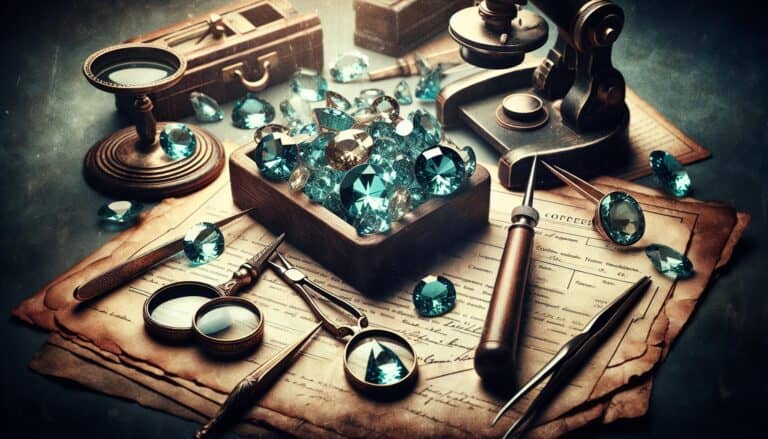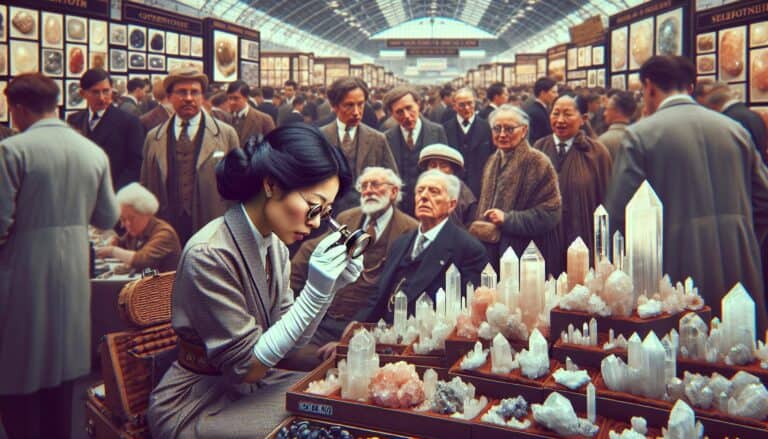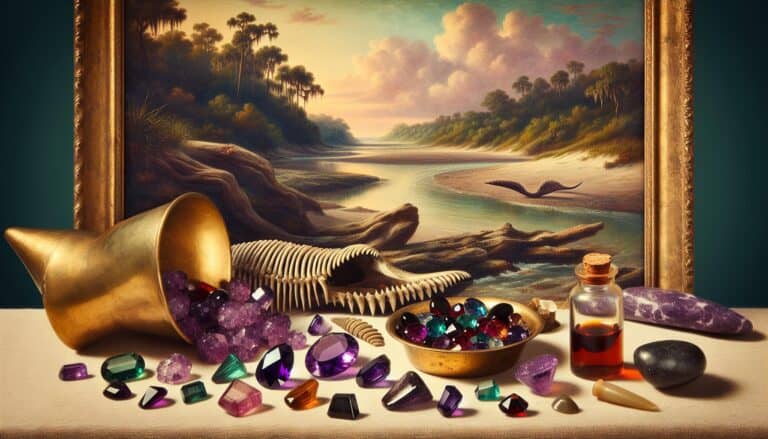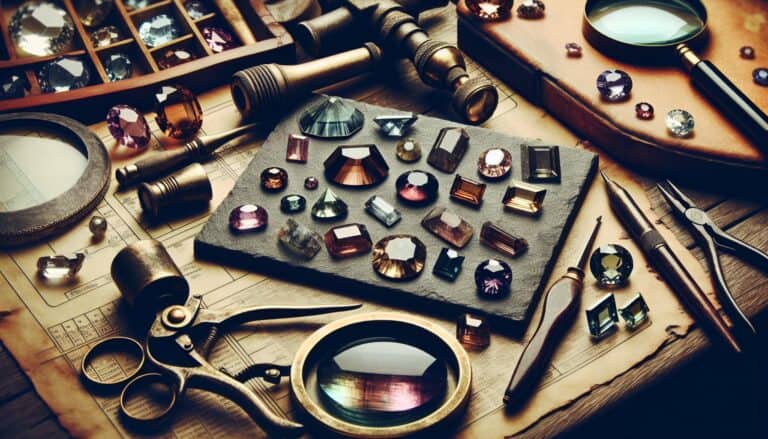Diving into the world of precious stones, you’ve likely heard of the star sapphire, a gem that captivates with its unique star-like pattern.
But how can you tell if you’re looking at the real deal? Identifying a genuine star sapphire is crucial, whether you’re a collector or just someone who appreciates their beauty.
The key to recognizing a true star sapphire lies in its distinctive features. From its remarkable asterism to its hardness on the Mohs scale, knowing what to look for is essential.
You’re about to unlock the secrets to distinguishing these gems from imitations, ensuring you can select a star sapphire with confidence.
Starry gleam on sapphire blue, real or fake, how do you know? Look for sharpness in the star, white streak it leaves afar. No magnet pull, hard as glass, cabochon crown, not too fast.
How to Identify Star Sapphire Through Testing
When you’re determined to confirm the authenticity of a star sapphire, various tests can help you in your quest. By understanding and implementing these testing methods, you can distinguish real star sapphires from imitations with greater accuracy.
Visual Inspection
A thorough visual inspection is your first step. Look for the telltale star-like pattern on the surface when exposed to direct light. This phenomenon, known as asterism, should be sharp and well-centered. Imperfections, such as interior fractures or color zoning, can also suggest authenticity since synthetic stones are often flawless.
The Streak Test
The streak test can tell you a lot without damaging the stone. Simply rub the sapphire across a piece of unglazed porcelain tile. A genuine sapphire will leave a white streak; any other color may indicate a fake.
Magnet Test
Most natural gemstones, including sapphires, are not magnetic. By placing a strong magnet near your stone, you can observe its reaction. Lack of attraction is no guarantee but it can be a helpful indicator in your identification process.
Hardness Test
Sapphires rank 9 on the Mohs scale of hardness, making them resistant to scratches from materials with a lower score. Use a scratch test, but proceed with caution to avoid potential damage.
Birefringence Test
Birefringence refers to a gemstone’s ability to refract two rays of light. To check for this, slowly rotate the sapphire above a single line on a piece of paper. If the line doubles at any angle, that indicates birefringence, which is not a characteristic of star sapphires.
Checking The Diaphaneity
Assess the gemstone’s transparency or diaphaneity. Star sapphires typically exhibit a translucent to opaque quality. If the stone is too clear, it might be a sign of a synthetic or treated gem.
Single or Double Refraction
Star sapphires are single-refractive gemstones. This means they should not have a double refraction effect when observed under polarized light. Double refraction is an indication that you might not have a genuine star sapphire.
Refractive Index Test
A refractometer measures the refractive index of gemstones, and a natural star sapphire should have readings between 1.760 and 1.770. Any measurement significantly outside this range raises a red flag.
Finding The Specific Gravity
The specific gravity of a star sapphire falls around 4.00. Testing this involves the use of a hydrostatic balance or heavy liquids—a reliable test but one to be done by professionals to avoid inaccuracies.
Identifying Star Sapphires in the Field
When identifying star sapphires in the field, look for their typical habitats: gravels or metamorphic rocks. Their distinct blue to violet-blue hues should stand out against the more mundane rocks.
Recognizing Potential Star Sapphire Rocks
Understanding the origin of star sapphires is key to recognizing them in nature. They typically form in alkaline basalts and are found in riverbeds among alluvial deposits. Familiarize yourself with your area’s geology to increase your chances of finding these precious stones.
Physical Characteristics of Star Sapphires
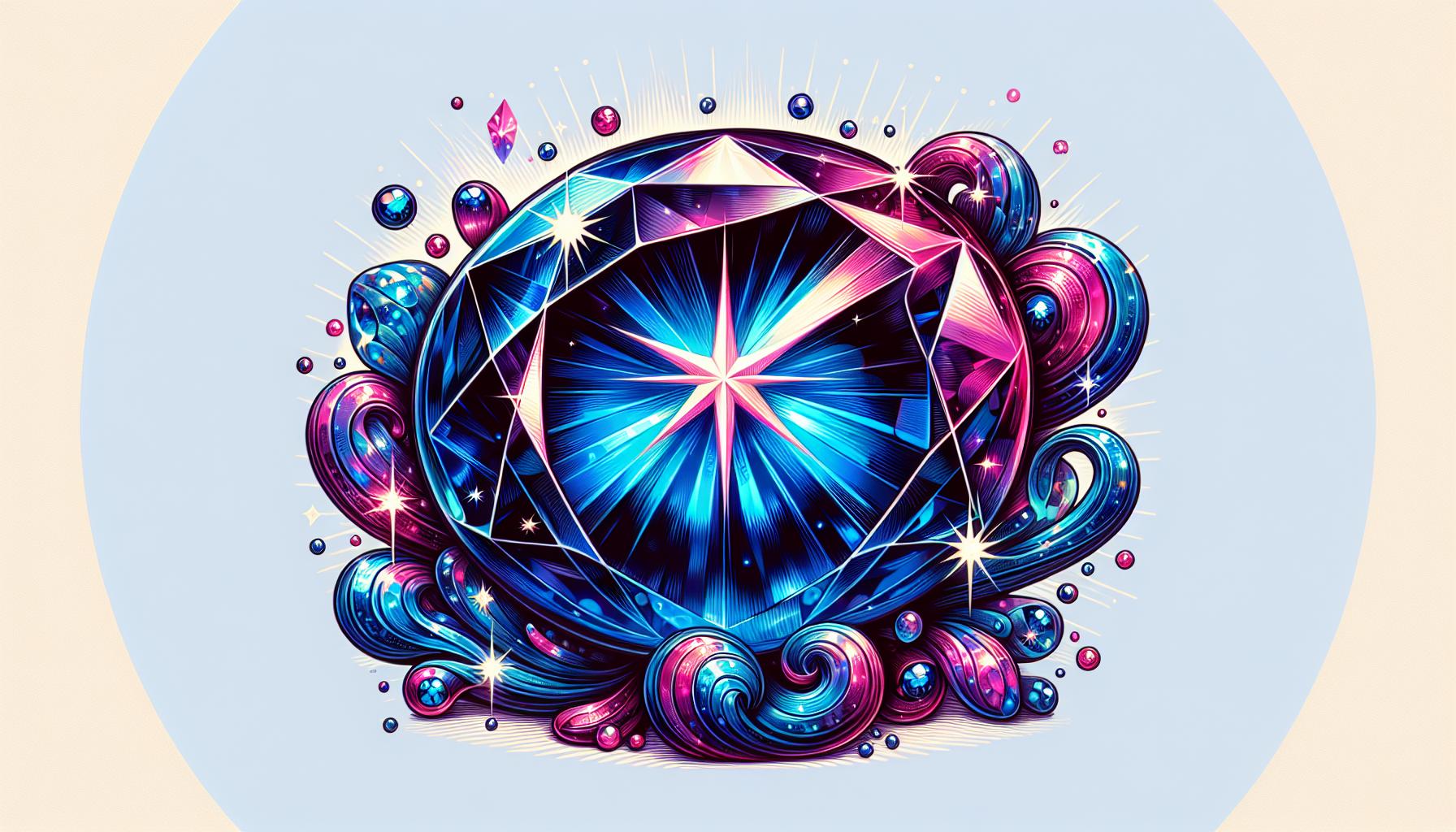
Star sapphires, a wonders of nature, are prized for their unique asterism, but there’s more to them than the star effect alone. The phenomenon is caused by needle-like inclusions of rutile, also known as “silk”, aligned in three intersecting directions. These sapphires come in a variety of colors, with blue being the most popular, followed by pink, white, and yellow.
When judging star sapphires, understand that an ideal star has sharp rays and a well-centered asterisk. The star should move across the stone’s surface as you rotate it in the light, showing a lively and well-defined star which suggests high quality.
Color and Saturation
- Blue sapphires should have a vivid, intense blue hue.
- Pale or overly dark stones are typically less valuable.
Size and Shape
Commonly, star sapphires are found in cabochon cuts, a style that enhances the star effect. The dome of the cabochon should be smooth and proportionate; uneven or overly high domes may detract from the stone’s beauty and value.
Transparency
While generally opaque, some star sapphires exhibit a degree of translucency. This trait can add to the stone’s allure and increase its worth. However, too much transparency can impact the visibility of the star.
By scrutinizing these physical characteristics, you’ll be well on your way to identifying genuine star sapphires amidst the myriad of gems. Keep in mind that natural imperfections may exist, but these should not overly diminish the star sapphire’s overall appeal.
Star Sapphire vs Sapphire vs Rough Sapphire
Rough Sapphires are the unadorned gems in their natural state, freshly unearthed from the depths of the Earth. These specimens possess a raw, unpolished allure, characterized by their irregular shapes and rough, untamed surfaces. Their true beauty lies concealed until skilled craftsmen unlock their potential through cutting and polishing.
Star Sapphires, in contrast, offer a celestial spectacle. These gems exhibit a captivating optical phenomenon known as asterism, forming a stunning star-shaped pattern when illuminated. This phenomenon is a result of needle-like rutile inclusions within the stone, creating a mesmerizing and otherworldly effect that captures the imagination.
Sapphires are the polished and refined gemstones adorning jewelry and cherished for their exceptional attributes. Sapphires are renowned for their vivid colors, remarkable hardness (second only to diamonds), and the symbolism they carry, often associated with virtues like loyalty, wisdom, and nobility. While blue sapphires are the most iconic, sapphires can be found in a diverse palette of hues, from romantic pinks to sunny yellows, and even elegant colorless variations.
How Are Star Sapphire Formed?
Star sapphires are created through a remarkable process that begins deep within the Earth. Corundum, the mineral from which star sapphires are formed, is a crystalline form of aluminum oxide and is typically found in metamorphic rocks. It’s the presence of trace elements such as iron, titanium, chromium, copper, or magnesium that gives the sapphire its color.
As these sapphires form, rutile (titanium dioxide) inclusions, often referred to as “silk,” develop within them. The unique star-like phenomenon, known as asterism, is the result of light reflecting off these silk inclusions. It requires a precise alignment of the rutile within the crystal lattice to create the effect of a six-ray star when the stone is cut into a cabochon. The process is both complex and natural, leading to each stone’s uniqueness.
The formation of these gemstones takes place over millions of years, under conditions of intense heat and pressure that cause the rutile to align along with the crystal’s natural growth patterns. The stones are often found in alluvial deposits where rough crystals are washed downstream and deposited in layers of gravel or clay.
When you’re on the hunt for star sapphires, remember that authentic stars are formed by nature and each exhibits its own idiosyncratic star pattern. Unlike synthetic counterparts, which can have too perfect stars, the authentic ones often show slight variations that add to their charm and value.
Preparation for Star Sapphire Hunting
Gathering the Right Tools
Before you head out on your quest to find genuine star sapphires, it’s crucial to have the necessary tools at your disposal. Proper equipment can be the difference between a fruitless search and an exciting discovery. A loupe or magnifying glass is a must-have for inspecting potential finds for asterism. You’ll also want a reliable hardness test kit to perform on-the-spot assessments of stones’ durability.
Don’t forget to pack a streak plate to conduct a streak test. It’s helpful to have a small magnet and flashlight as well to further investigate the physical properties of the gems you come across. If possible, bring along a refractometer; though they can be quite an investment, they are incredibly useful for identifying the refractive index of your findings – a clear indicator of authenticity. Have a notebook and pen ready to jot down any observations or characteristics that might help you later in identifying your star sapphire’s value and authenticity.
| Must-have Tools | Purpose |
|---|---|
| Loupe or Magnifying Glass | To inspect stones for asterism |
| Hardness Test Kit | To assess stone durability |
| Streak Plate | For conducting a streak test |
| Magnet | To test magnetic properties |
| Flashlight | To scrutinize stones in different lightings |
| Refractometer | To determine the refractive index |
| Notebook and Pen | For noting down observations and characteristics |
Safety Considerations
Your safety should be your top priority when hunting for star sapphires. Always ensure you’re dressed for the occasion. Wear protective gear such as gloves and safety glasses to shield yourself from potential hazards. Appropriate footwear is essential, especially if you’re traversing rough terrains known to house these gems.
It’s wise to prepare for the weather as well. Bring along sunscreen and a hat for sun protection, or a raincoat for unexpected showers. If you’re going into the wild, it’s crucial to have a first-aid kit and map or GPS device. Always let someone know where you’ll be and how long you expect to be out.
Carry an adequate water supply and some energy-boosting snacks to maintain hydration and energy levels. Never underestimate the importance of being prepared for emergencies; so include a whistle, fire-starter, and multi-tool in your gear.
| Safety Essentials | Purpose |
|---|---|
| Protective Gear | To protect against physical hazards |
| Appropriate Footwear | For safe navigation of terrains |
| Sunscreen and Hat | To protect from sun exposure |
Handling and Care of Found Star Sapphire

Once you’ve successfully identified and collected star sapphires in the field, your next priority is ensuring they maintain their luster and star-like qualities. Proper handling and care are crucial to preserve these precious gems for years to come. From gentle cleaning techniques to safe storage solutions, follow these guidelines to protect the beauty and value of your star sapphires.
Cleaning and Storing Star Sapphires
The mesmerizing star effect in star sapphires demands careful cleaning to keep the stones shining. Avoid harsh chemicals or ultrasonic cleaners, as they can damage the rutile inclusions that create the star effect. Instead, opt for a softer approach:
- Gently clean your star sapphires with a mixture of warm water and mild soap.
- Use a soft-bristled brush, such as a toothbrush, to carefully remove dirt and dust from the stone’s surface.
- Rinse thoroughly with clean water to remove any soap residue.
- Pat the stones dry with a soft, lint-free cloth.
After cleaning, properly storing your star sapphires is equally important to prevent scratches or damage:
- Wrap each sapphire separately in a soft cloth or place them in a fabric-lined jewelry box.
- Keep star sapphires away from harder gemstones that could scratch them.
- Store them in a cool, dry place, away from direct sunlight or any heat source to prevent color fading.
By adhering to these simple yet effective cleaning and storage practices, you’ll ensure your star sapphires retain their natural allure and stellar appearance for all your future endeavors. Whether you’re an avid collector or a casual admirer, taking good care of these gems is key to enjoying their unique splendor. Keep in mind that periodic cleaning and diligent storage not only safeguard the gem’s physical appearance but also uphold its market value, should you decide to trade or sell your findings.
Conclusion: Confirming Real Star Sapphires
You’ve now got the tools and know-how to identify a star sapphire with confidence.
Remember that your careful examination and the care you provide for these gems will ensure their star quality shines for years to come. Treasure the experience of uncovering one of nature’s marvels and enjoy the journey from discovery to preservation of your star sapphire. Whether for personal enjoyment or as a valuable addition to your collection, the allure of a star sapphire’s unique beauty is undeniable.
Embrace the process and trust your newfound expertise to guide you.


